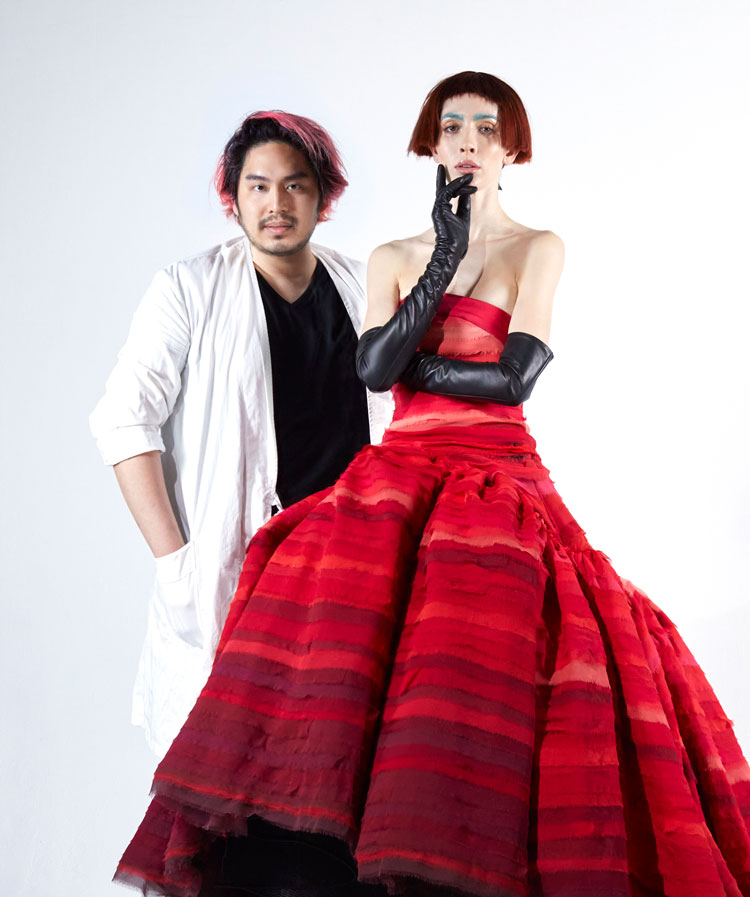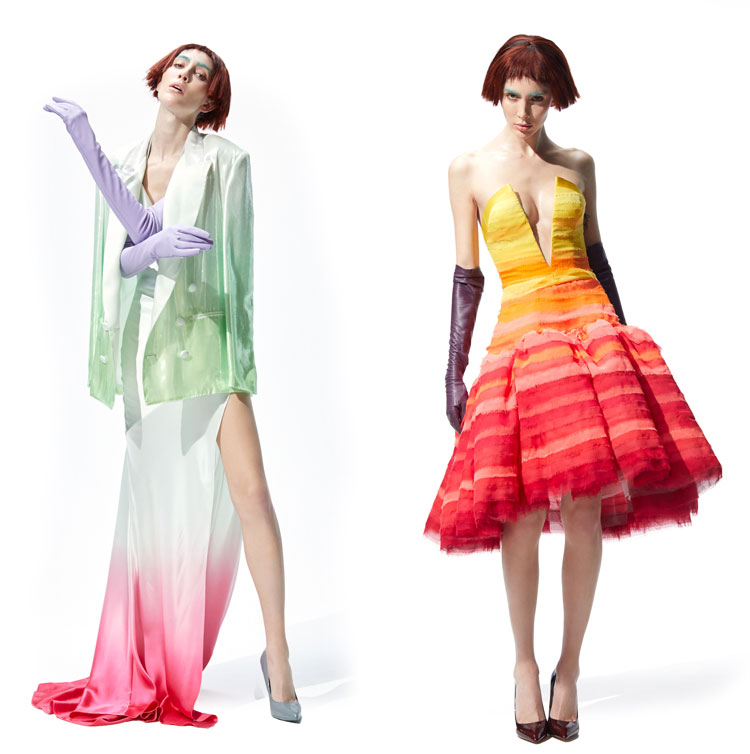
COVER STORY: Groundbreaking Glamour
Bach Mai’s cutting-edge designs transform traditional notions of femininity.

Houston designer Bach Mai has been designing for more than half his life, and at 33, he is only getting started. He discovered his love of fashion as a child, and started making dresses when he was 15.
“Fashion has this amazing power where when someone puts on something, regardless of aesthetic, it makes them feel incredible—[like they] can take on the world. That’s a very beautiful power that fashion has,” Mai says.
A gay Vietnamese man, Mai has an extensive background in fashion design, having studied at Parsons School of Design in New York City and Institut Français de la Mode in Paris. He has worked with industry giants like John Galliano, Calvin Klein, Oscar de la Renta, and Maison Margiela. Mai was also touted by Vogue as “an American couturier in the making” and “fashion’s next big thing” by PaperCity, a statewide lifestyle publication that covers fashion, lifestyle news, and more.
Mai’s designs were recently featured at several major red-carpet events. Singer-songwriter Abigail Barlow wore one of his dresses to the Grammy Awards, and actress Josie Totah wore two of his designs to the GLAAD Media Awards.
Mai’s clothes celebrate femininity, sexuality, and sensuality. While he doesn’t currently produce haute couture, he has a deep respect and love for that custom high-end craft. He is partnering with Hurel, one of the oldest and most prestigious fabric houses in France, to create clothes inspired by the haute couture tradition.
In addition to admiring the craftsmanship that goes into haute couture, Mai especially loves the collaborative process it requires. “I think one of the most important parts about haute couture is the relationship between the client and designer, where I can make anything happen.”
Learn more about Bach Mai in our OutSmart interview below.
What is “haute couture,” in your own words?
Haute couture is everything. It is the highest level of design, the highest level of sewing, the highest level of craftsmanship, but it’s also a creative laboratory of design where anything is possible. It is this intimate relationship between the client and designer. It is making these really special custom clothes for someone to help them take on the world.
People always ring the death bell for haute couture, but it never goes away because it continues to evolve to meet the needs of whatever the times are.

Tell us what it was like growing up gay and Vietnamese in Houston?
I grew up in very supportive familial and academic communities. I think a lot of people think, “Oh my gosh, you must have had such a traumatic experience.” But I really didn’t. I think what it allowed me to do was to leave Texas at 18, so confident in who I was.
I ended up going to the very liberal Saint John’s High School. Looking back on that experience, it was such a supportive community, at least relative to what you hear about other people’s experiences in high school. I remember being a freshman and there would always be upperclassmen who were out and proud and accepted. Overall, I’m very thankful for my experience growing up in Houston.
When did you develop an interest in fashion?
I developed an interest in fashion quite early on. I always credit John Galliano’s Christian Dior Spring 2004 Couture collection for my love of haute couture. It really opened my eyes to what fashion and couture could be. I was very young, and remember sitting at the little dial-up computer and watching the runway videos online. That show will forever be one of my favorite shows of all time. He really showed what was possible with fashion. It was not just clothes; it is the power to make you dream, to stir emotion. It is also the power to make women beautiful. It is the power to tell a story. That’s why he has such a special place in the history of fashion.
What was the first piece of clothing you made, and how was it important to you?
I made this red bias-cut slip dress for my cousin. I didn’t design it. It was me learning how to sew using a pattern.
The bias cut, it’s like magic. The fabric, when cut on the bias, changes and moves and grows and starts to have a life of its own. As you wear it, it conforms more because of your body heat. Its ability to conform to a body and become alive with the wearer is very magical. When I see a bias dress with a dart in it, I almost have a heart attack every time.
How did you find your voice while working alongside so many fashion-designer icons?
[By developing] a strong and defined personal creative universe. No matter where you go, you bring your creative universe, and you incorporate it into theirs. That’s how you maintain yourself, and that’s what you provide.
Creative universes are the things that make you tick. It’s the references that you love, the works that inspire you and continue to inspire you, collection after collection. I have so many—my obsession with the courtesan 18th-century dress, haute couture from the ’50s and ’60s, Cy Twombly, ballet, opera. I mean, I can go on and on.

What else inspires your work?
Femininity. I really reject this idea that women have to adopt masculine codes of dress to appear strong. I think that’s such a fallacy. Feminine [styles] can be powerful, strong, and they can be used as armor.
I think this whole ’80s idea of the power suit—needing to wear this strong-shouldered pinstripe suit to be seen as powerful in the board room—is like, whatever. You can also wear a beautiful bias cut for work.
My brand really revolves around this idea of “unabashed femininity” and “irreverent glamour.” Unabashed femininity is embracing feminine codes and using them in powerful ways. Irreverent glamour comes from a very Texas idea of glamor. [I saw it while growing] up, and saw not only how my friends dressed and approached glamorous dressing, but also how their mothers [approached it].
Describe your ability to provide high-profile clients with designs that look amazing and make them feel amazing.
Abigail wore something from our first collection to the Grammy Awards. We did a custom dress for Josie for the GLAAD Awards. I was watching Bridgerton at that moment, so it was a very Bridgerton-inspired dress. The collaboration with her and her stylist was the most beautiful part of couture—the relationship between the client and designer. Being able to have that conversation with them, make something custom, and send fabric swatches to check them on her skin to make sure we found the absolute perfect shade of chartreuse was so fun and inspiring to me. And she looked incredible! We sent an extra, and she loved it so much, she wore two looks. It’s nice when people respond to your work in that way. It’s an amazing feeling to be able to empower someone with your clothes.
Tell us about the inspiration for your latest collection, A Flower Walk.
My collection 0, which is the first collection I showed last year, was really inspired by my creative universe and my mentors. I started before the pandemic, and then we were on pause for two years. I’ve been looking at this collection for years, waiting to launch. It ended up being very dark, and after another long, dark COVID winter, we just needed color, color, color, color. So I started again with the cornerstone of my creative universe, Cy Twombly—specifically the exhibition he did in Southern France called Blooming, A Scattering of Blossoms and Other Things. Unlike his usual penchant for looking at classical poetry, Twombly was looking at Japanese haiku.
One haiku that struck me was by Takarai Kikaku, in which Kusonoki took off his armor for peonies, and it really brought me to the idea of the disarming power of femininity. I was also looking at Ukiyo-e (particularly Bijin-ga, which is a genre of Japanese art focused on feminine beauty) and the courtesan of the season, the Oiran—one of the highest levels of Japanese courtesans. What I really loved was the idea of the Oiran Dochu, which is kind of the precession they do after this long courtship ritual where she goes to meet a patron. All the finery, all the attendants, and the special way of walking was just mesmerizing. So, I translated Oiran Dochu to kind of mean “flower walk,” which is where my collection’s name comes from.
At the end of the day, it was about color, color, color, color, and each look was ombré.
Walk us through your creative process. How do you go about producing a design, from start to finish?
I get this question a lot, and maybe I work a little differently, but what I find is that there’s not just one pathway. Every collection has its own life, its own needs, and you just have to go on the journey it needs to go on. So sometimes that means sketching, and sometimes that may be painting and draping. It may be more fabric-based, more shape-based, or more image-based. I just start wherever it needs to start, and it goes where it needs to go. There’s always a textile component with me, but there’s never just one way.
What are some of the most important lessons you’ve learned as a designer?
Focus on the craft. There’s a lot now about image and social-media marketing, but at the end of the day, it’s about the clothes.
What’s next for you and your brand?
To continue building this vision, this brand, and refining and establishing my identity and my voice in fashion.
We’ll be in retail stores for the first time ever. There’s nothing more special than seeing people wear your clothes. We will be in Neiman Marcus in July. I’m excited to not only see the clothes there, but also to do an event or trunk show and get to see more of the clients.
For more info, visit bachmai.com.
This article appears in the May 2022 edition of OutSmart magazine.











Comments